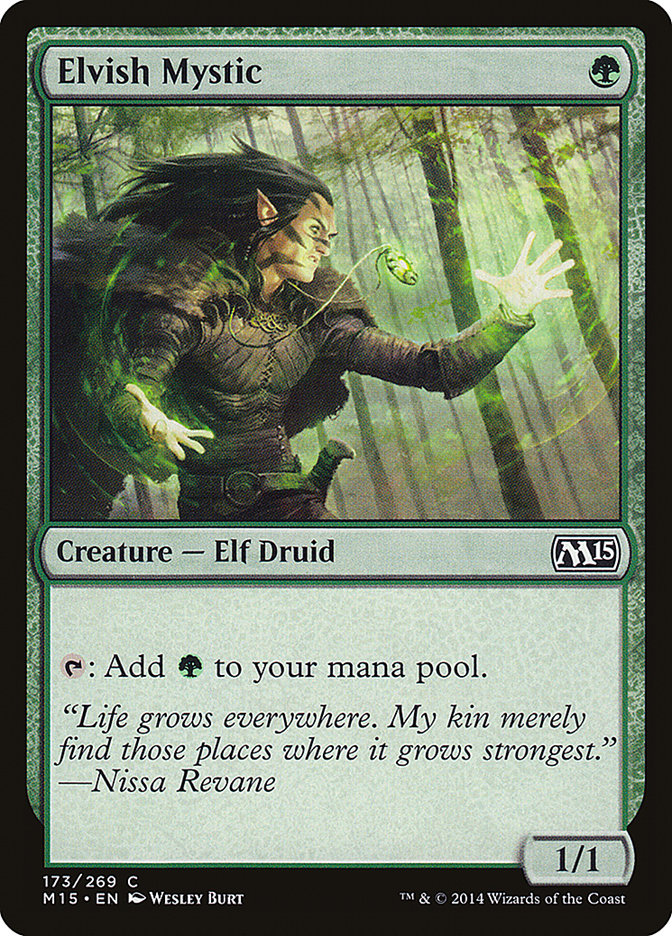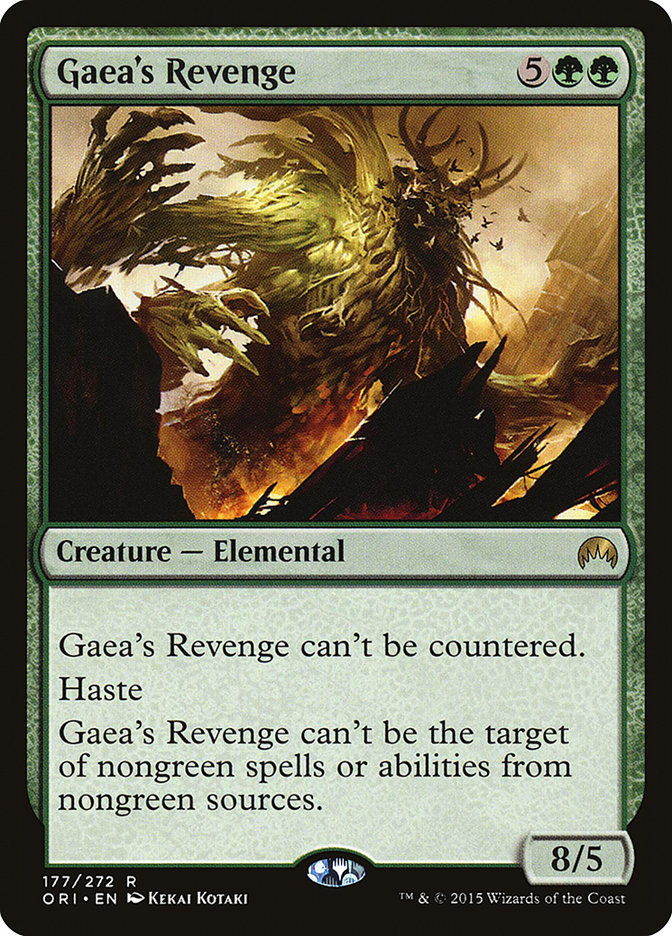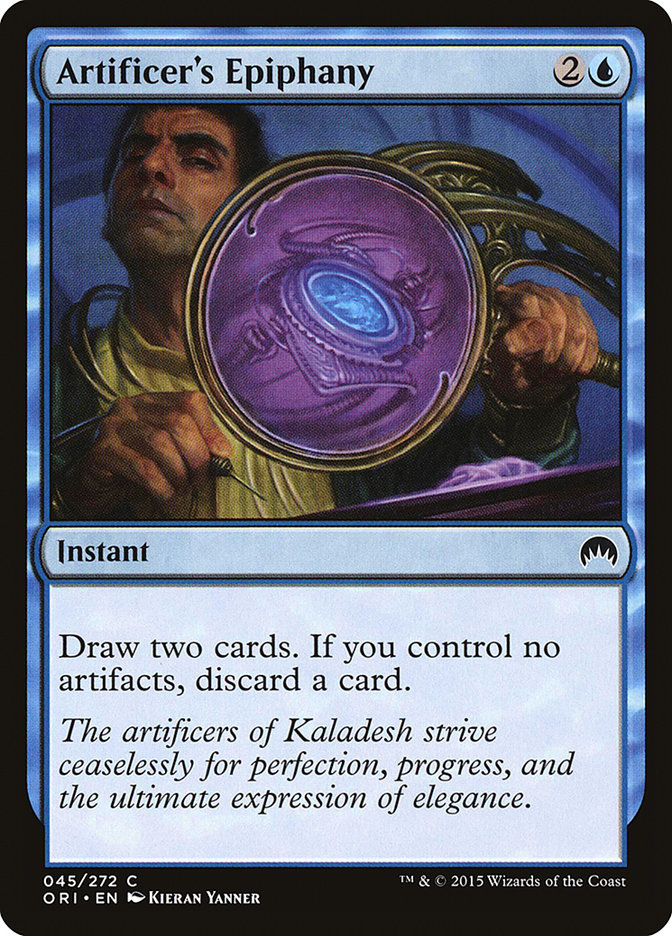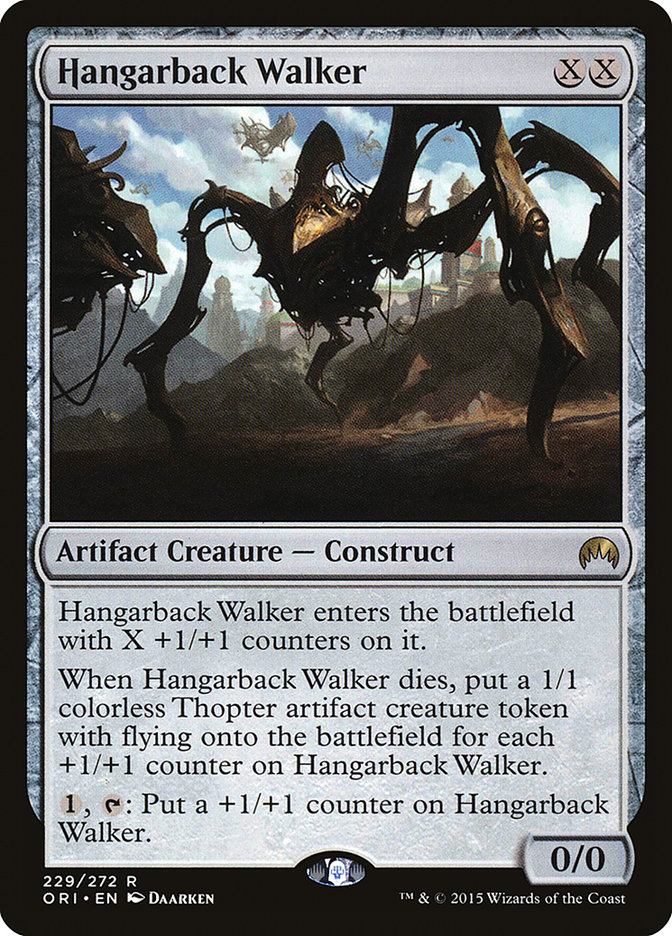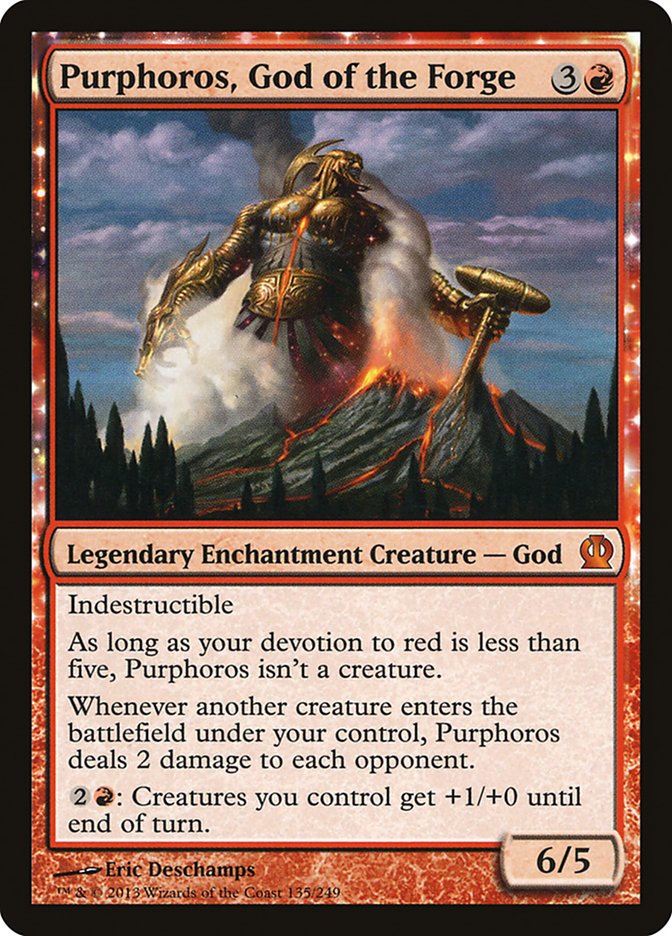As has become the norm in recent years, the first results of a new Standard format come to us courtesy of the Open Series. Magic Origins made its tournament debut this past weekend in Chicago, and the final Core Set’s influence was clear all weekend. Viewers tuned in to SCGLive to see all kinds of exciting new decks in action, from TurboFog to Five Color Rally to U/W Thopter Control. When the dust settled, however, it was a boogeyman of old that dominated the standings.
While G/R Devotion took the title along with three of the four top spots, it’s certainly too early to make any judgements about the impact of Magic Origins. It takes time for players to experiment with new cards and build new decks while those picking up faithful old decks have all the benefits of months of playtesting. It’s easy for a tournament environment to expose glaring weaknesses in a strategy that could be fixed with just a few different card choices, but the impact of those potential changes can’t be seen in Week One results.
Additionally, with the Pro Tour on the horizon many qualified players may intentionally refrain from exposing new technology for fear of leaking it before the big show. A player like Brad Nelson is much more likely to show up to a Standard Open with a known commodity than an experimental new deck, as the latter has surprise value worth saving for Vancouver in a few weeks.
That said, G/R Devotion is clearly a very powerful deck. It gets to play a huge amount of mana acceleration, including what I feel is the single best card in the format: Elvish Mystic. One-drop mana creatures have been a fixture of competitive green decks since Magic’s early days. Their traditional weakness has always been their vulnerability to board wipe effects, like Wrath of God or Supreme Verdict. But in the current Standard format, all of the true sweepers cost at least five mana with only the recent addition of Languish clocking in at the old four-cost slot… and that can’t kill many of the big creatures G/R Devotion can play by then!
On top of the increased cost of sweepers making life easier for mana creatures, G/R Devotion also benefits from access to a huge swath of creatures and planeswalkers that are highly resilient to removal and countermagic. Trying to keep up with one-for-one removal against cards like Whisperwood Elemental, Genesis Hydra, and Xenagos the Reveler is a recipe for disaster, especially when the G/R Devotion player is always a step ahead thanks to Elvish Mystic and friends. Even decks that are traditionally strong against ramp strategies, like U/B Control, will find themselves struggling to keep up with this mix of threats.
But things are even worse for control decks with the introduction of Magic Origins thanks to Gaea’s Revenge. While the successful G/R Devotion decks in Chicago had a number of differences, one thing they clearly agreed on was the importance of packing their sideboards full of Gaea’s Revenge. With Languish as the most commonly-played sweeper card and nary a Sultai Charm to be found, Gaea’s Revenge is nearly unkillable against many control decks, providing a way for ramp decks to break through even fistfuls of countermagic and removal.
If there is a deck to beat heading into the Pro Tour, G/R Devotion is it. While there are variations in individual card choices among the top-finishing decks in the Standard Open, the core of the deck – fast mana and giant monsters – is where its true power lies.
Creatures (31)
- 1 Hornet Queen
- 4 Elvish Mystic
- 4 Polukranos, World Eater
- 4 Sylvan Caryatid
- 4 Courser of Kruphix
- 2 Genesis Hydra
- 4 Rattleclaw Mystic
- 1 Ashcloud Phoenix
- 4 Whisperwood Elemental
- 3 Dragonlord Atarka
Planeswalkers (4)
Lands (12)
Spells (13)

Creatures (33)
- 1 Hornet Queen
- 4 Elvish Mystic
- 4 Polukranos, World Eater
- 4 Sylvan Caryatid
- 4 Courser of Kruphix
- 3 Genesis Hydra
- 4 Rattleclaw Mystic
- 4 Whisperwood Elemental
- 3 Dragonlord Atarka
- 2 Nissa, Vastwood Seer
Planeswalkers (3)
Lands (13)
Spells (11)

Creatures (33)
- 4 Elvish Mystic
- 3 Polukranos, World Eater
- 4 Sylvan Caryatid
- 4 Courser of Kruphix
- 3 Genesis Hydra
- 4 Rattleclaw Mystic
- 4 Whisperwood Elemental
- 4 Dragonlord Atarka
- 3 Deathmist Raptor
Planeswalkers (3)
Lands (13)
Spells (11)

Thankfully, for players whose idea of a good time is something other than ramping into giant green creatures, there are other exciting options out there – including some that seem likely to match up well against Dragonlord Atarka and friends. Jeff Hoogland made Top Eight of the Standard Open with a very interesting take on U/W Control, focusing on Magic Origins’ artifact theme… most notably Thopter Spy Network.
Creatures (4)
Planeswalkers (4)
Lands (27)
Spells (25)

While big green creatures are much more my style, I have to respect Jeff’s innovations here. Thopter Spy Network is basically a cross between a Bitterblossom and a Howling Mine, both of which are effects that a control deck is very interested in. Once the Network gets going, it feeds on itself, providing not only more Thopters to keep its abilities going but also digging you deeper to countermagic to protect it and further artifacts to keep it online.
Artificer’s Epiphany is also an interesting choice. Divination isn’t a card that I’m super excited about playing in general, but make it instant speed in a deck that really does want to keep its mana untapped for countermagic with Dissolve or Clash of Wills and suddenly it’s a lot more compelling. Control decks often want a little bit of extra card draw in the early turns, helping to ensure that they hit their land drops and piece together the other resources they need to stay in the game. Epiphany helps Jeff’s deck do exactly that while not forcing him to drop his shields in case his opponent plays a significant threat before he’s ready.
The other really cool card in here that flew under most players’ radars is Hangarback Walker. While the Walker takes some time to really get going, it’s a creature that can come down early that threatens to take over any game that goes long. Unlike with most creatures in control decks, you don’t have to worry about it being a lightning rod for your opponent’s removal – even if it dies, you get the value of all of those Thopters bursting out and demanding removal once again. Early proactive plays are usually pretty rare in control decks, which is what makes this a particularly interesting inclusion to me.
I like the fact that between Hangarback Walker and Thopter Spy Network this deck actually has some reasonable ways to pressure opposing planeswalkers. One of the big liabilities of U/W compared to U/B Control recently has been the lack of Hero’s Downfall and thus a much greater weakness to cards like Xenagos and Nissa. Hoogland’s deck can make not just Thopter tokens from his artifact synergy cards but also Soldier tokens from Elspeth to march on opposing planeswalkers. The inclusion of Spy Network alongside Elspeth also offers a win condition that can stand up against Downfall, not to mention sweepers like Languish or Crux of Fate, which has been a drawback of cards like Elspeth or Dragonlord Ojutai in the past.
The tradeoff, of course, is that while Spy Network can’t be killed by Downfall, it can be destroyed by Dromoka’s Command, which has been a very popular card in Standard. Many decks have cut incidental enchantments like Banishing Light in order to avoid getting blown out, and leaning on Thopter Spy Network walks right back into it. Maybe that’s fine because many Dromoka’s Command decks are going to struggle to beat End Hostilities and Elspeth anyway, but it’s something worth keeping in mind about your local metagame before playing a deck like this.
The importance of enabling Thopter Spy Network and Artificer’s Epiphany in this deck makes the inclusion of just three copies of Darksteel Citadel quite strange to me. I could understand if perhaps Jeff felt that he was light on colored mana, but he even has a copy of Radiant Fountain! I have to imagine that lacking an artifact early in the game to enable key synergies has to be a bigger deal than occasionally gaining two life. Maybe it’s a minor consideration, but it seems like if you’re going to be playing cards that need artifacts to operate – especially ones that you want to turn on early in the game like Artificer’s Intuition – you want to max out on Citadels before you touch another colorless land.
But enough about artifacts. While Hoogland’s deck was definitely an interesting one, another stood out to me – and many others – as by far the coolest deck of the tournament.
Creatures (30)
- 4 Nantuko Husk
- 4 Elvish Mystic
- 3 Sylvan Caryatid
- 2 Mogis's Marauder
- 4 Satyr Wayfinder
- 3 Grim Haruspex
- 2 Den Protector
- 3 Deathmist Raptor
- 1 Liliana, Heretical Healer
- 4 Jace, Vryn's Prodigy
Lands (20)
Spells (10)

This deck is awesome. The plan is to fill your graveyard with creatures using Sylvan Wayfinder, Gather the Pack, and Jace, Vryn’s Prodigy, then play a Rally the Ancestors bringing back Mogis’s Marauders, Nantuko Husk, and whatever other garbage creatures are around to sacrifice to the Husk so it’s big enough for a single lethal attack. If you don’t win right away, Grim Haruspex lets you trade in all of those creatures for cards while Jace can flip immediately thanks to the haste from Mogis’s Marauders and let you flash back your Rally to do it again next turn (assuming you milled another one).
This deck is one of those that I talked about earlier on – a new brew with glaring weaknesses that may not have manifested in testing, but which get exposed over the course of the tournament. Matthew Tickal started out the Chicago Open with an 8-0 record despite a number of self-admitted mistakes that cost him games. Eventually, though, his deck’s sheer rawness and his unfamiliarity with its particular style of play caught up with him, and he finished the tournament narrowly outside the Top 32.
One of the issues he ran into was his inability to kill Jeff Hoogland through a swarm of Thopter tokens. Hilariously, Mogis’s Marauder gives creatures Intimidate, which means they can still be blocked by artifacts – like Hangarback Walker’s progeny, or the tokens that come out of Thopter Spy Network. Despite churning through his deck, Tickal couldn’t find anything that could allow him to overcome the little flying robots, and eventually he succumbed.
A more refined version of the deck would almost certainly include some way to win in a situation like this. Interestingly, I actually ran into a player at my local store while I was spellslinging at the Magic Origins Prerelease who had found the answer. He was also playing a Rally the Ancestor’s deck, and while I believe his version wasn’t as refined or as powerful overall as Tickal’s, his win condition ignored combat entirely and could easily find its way into this version of the deck:
Purphoros provides the Rally deck with the ability to end the game on the spot with a big enough graveyard no matter how many blockers or removal spells the opponent might have. Tickal’s deck can already produce red mana to cast it in a pinch – in fact, he already has red cards in his sideboard thanks to a pair of Kolaghan’s Commands. My understanding is that those were intended as a solution for Perilous Vault, since the artifact can prevent him from making his single big lethal attack. Purphoros actually serves much the same purpose by ignoring the Vault’s effect entirely: the opponent dies immediately from the enters-the-battlefield triggers the red god generates whether you pop the Vault in response or not.
The ability to mitigate both the problem of Perilous Vault and blocking Thopters in a single card leads me to believe that Purphoros really ought to have a home in this deck. I’d likely want a single copy in the maindeck just as a safety valve, and then probably a second in the sideboard for matchups where it can be difficult to win in combat, though I don’t presume to know the deck well enough to suggest what ought to be cut.
So whether you want to play big green monsters, control the game with swarms of Thopters at your side, or kill your opponent with one huge combo turn, Standard has a deck that’s right for you! Magic Origins has only been legal for one week and already it’s made quite the mark on the format. With the Standard Open in Richmond coming up this weekend and the Pro Tour in Vancouver the next, I’m sure we’ll see any number of other powerful new strategies coming out of the woodwork.
What do you think? Is there a deck out there that can truly dethrone G/R Devotion? What new Magic Origins cards are poised to break out in Standard next?

